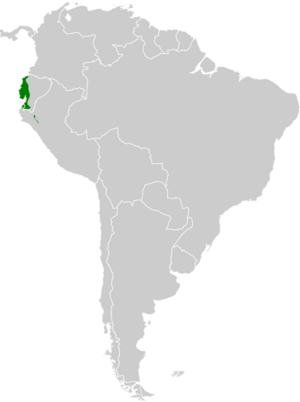Ecuadorian ground dove facts for kids
Quick facts for kids Ecuadorian ground dove |
|
|---|---|
 |
|
| Conservation status | |
| Scientific classification | |
| Genus: |
Columbina
|
| Species: |
buckleyi
|
 |
|
| Synonyms | |
|
|
The Ecuadorian ground dove (Columbina buckleyi) is a small bird that belongs to the Columbidae family, which includes doves and pigeons. You can find this special bird living in the countries of Ecuador and Peru in South America.
Contents
What is the Ecuadorian Ground Dove?
Scientists group animals based on how they are related. The Ecuadorian ground dove was once placed in a different group called Columbigallina. Later, it was moved into the Columbina group, where it belongs now.
This dove is also very similar to the ruddy ground dove. They are so alike that they are considered a "superspecies," meaning they are closely related but still different species.
Subspecies of the Ecuadorian Ground Dove
Just like people can have different family names, animals can have different types within a species. These are called subspecies. The Ecuadorian ground dove has two main types:
- The first type is called C. b. buckleyi.
- The second type is called C. b. dorsti.
What Does the Ecuadorian Ground Dove Look Like?
The Ecuadorian ground dove is about 18 centimeters (7 inches) long. That's about the length of a standard pencil! It weighs around 57 grams (2 ounces), which is about the same as a small apple.
Male vs. Female Doves
Male Ecuadorian ground doves have a pretty grayish-pink color on their forehead and face. This color gets darker, turning into a deep pink on their chest and belly. Their head and neck are bluish-gray, and their upper body is brownish-gray. When their wings are folded, you can see lines of black spots. Their middle tail feathers are gray, and the outer ones are black with white tips.
Female doves are a bit different. They are usually browner than the males and have less of that pink color.
Where Do Ecuadorian Ground Doves Live?
The first type of Ecuadorian ground dove, C. b. buckleyi, lives in north-western Ecuador. You can find them from the Esmeraldas Province all the way south to the northern part of Peru's Tumbes Department.
The second type, C. b. dorsti, lives in a separate area. They are found in the Marañon Valley in north-western Peru.
Their Favorite Places to Live
These doves like to live in many different kinds of places. They can be found in:
- Dry, open forests where trees lose their leaves.
- Thicker woodlands.
- Gardens and farms.
- Newer forests that are more humid.
They can live from sea level all the way up to 2,000 meters (6,560 feet) high in the mountains!
How Do Ecuadorian Ground Doves Behave?
What Do They Eat?
Scientists haven't studied exactly what the Ecuadorian ground dove eats yet. However, like other doves in its group, it probably eats small seeds.
How Do They Raise Their Young?
Ecuadorian ground doves have been seen building nests in February and March. Unlike many other doves that build flimsy nests out of sticks, these doves build strong, cup-shaped nests. They usually place their nests in bushes or trees, sometimes as high as 7 meters (23 feet) off the ground. When nests were found, they often contained two eggs.
What Do They Sound Like?
The song of the Ecuadorian ground dove is a series of soft, low cooing sounds. It sounds like "huWOO...huWOO...huWOO...." The sounds are spaced out evenly and go slightly upwards in pitch. You can listen to their song online!
Is the Ecuadorian Ground Dove Safe?
The IUCN (International Union for Conservation of Nature) is an organization that checks on how safe different animal species are. They have said that the Ecuadorian ground dove is of "Least Concern." This means they are not currently worried about it becoming endangered.
Even though it seems to be quite common, scientists still don't know a lot about its life and habits. Because it lives in a small area and we don't have much information, it would be very helpful to study this bird more!


